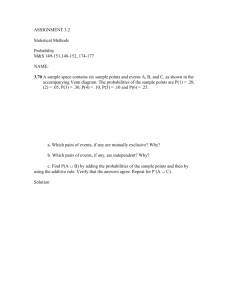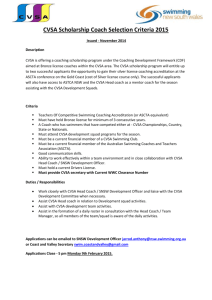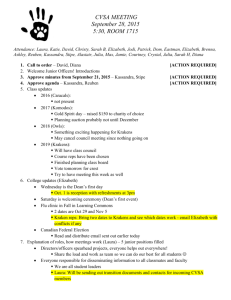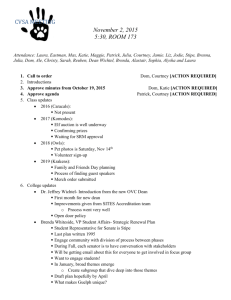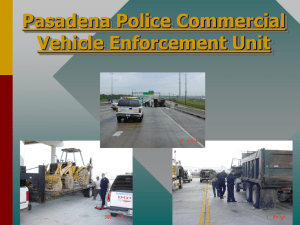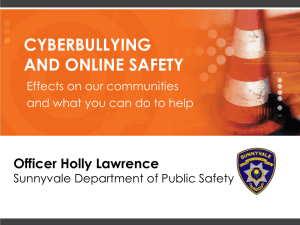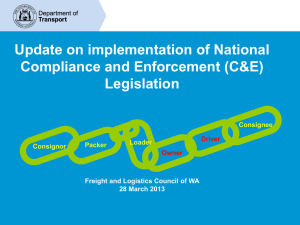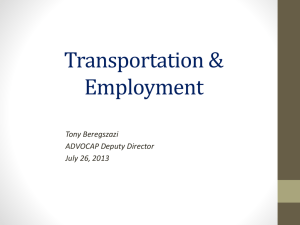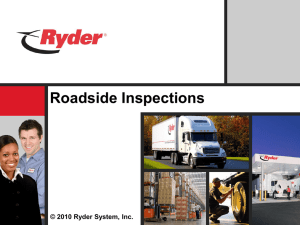HERE - Specialized Carriers & Rigging Association
advertisement
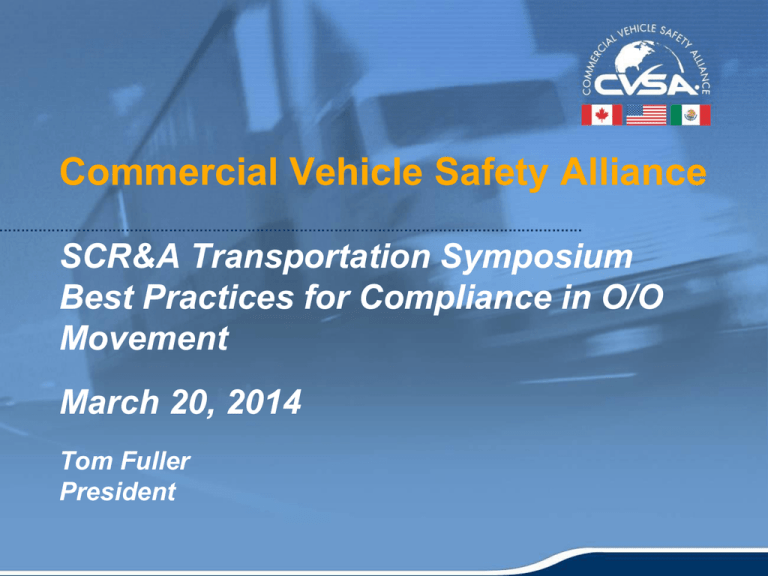
Commercial Vehicle Safety Alliance SCR&A Transportation Symposium Best Practices for Compliance in O/O Movement March 20, 2014 Tom Fuller President 1 About CVSA A non-profit 501(c)(3) trade association – 70 Members, 450 Associate Members – Began at industry’s urging in 1982 with several western States and Canadian provinces Why was it initiated? – Safety was a concern ------ deregulation – Need for uniformity and reciprocity in regulation, standards, and enforcement How does it work? – Support from public and private sectors critical – All CMV disciplines at the table and involved in setting and maintaining the standards – Focused agenda, clear expectations and results – Open the doors from the get-go – Processes and procedures for input and output are explicit and inclusive 2 CVSA Core Activities Roadside CMV Inspector Certification The North American Standard (NAS) Inspection Procedures – 7 inspection types NAS Out of Service Criteria NAS Training Program CVSA Decal Program 8 Technical Committees and 6 Programs that do the work 3 4 Special Committees Driver/Traffic Enforcement Hazardous Materials Information Systems Passenger Carrier Program Initiatives Size and Weight Training Vehicle Programs COHMED NAIC Level VI Operation Safe Driver Operation Air Brake Roadcheck 2013 “Top 10” Driver Violations 2013 “Top 10” Vehicle Violations 6 Policy Development and Advocacy Principal North America federal agencies are engaged in the dialogue – FMCSA, FHWA, PHMSA, NHTSA, RITA, TSA, DOE (United States) – Transport Canada, CCMTA (Canada) – SCT, Federal Police (Mexico) US Congress – Government Affairs – Legislative activity – Testify at hearings Industry has a seat at the table. 7 Current Policy Issues Regulations – – – – – – – – 12 Outstanding Petitions for rulemaking Bus Safety Hours of Service ELDs/Supporting Documents ELD Training MedCert GCWR/GVWR Drug & Alcohol Testing Programs – – – – – – – CDLIS/NLETS Integration Disqualified Drivers Distracted Driving Speed limiters Speed and Traffic Enforcement Fatigue Non-CMV Traffic Enforcement Language Proficiency Vehicle Issues – – – Cargo Securement Brakes, Lights and Tires Size & Weight Reauthorization CSA MCSAP (RIs, CRs, SAs, TE) Grant Administration CVSP Best Practices Data Quality/Uniformity and Safety Data Improvement Technology • Driver Issues – – – – – – – – – – MCSAC OOSO Enforcement Canada – – – – CVISN, WRI, Smart Roadside, Onboard Safety Systems Tax Incentives, Universal ID Safety Rating Reciprocity EOBRs Cargo Securement PMVI Mexico – – NAFTA NOM-068 8 MAP-22(?) MAP-21 has a bunch of good stuff in it, but FMCSA has a heavy lift – B+ is our grade, implementation is key. Lack of movement on enroute bus inspections and expansions of exemptions in Bill are problematic for enforcement MAP-22 CVSA Task Force – CVSA Policy positions developed – Enforcement and industry – Outreach ongoing 9 CVSA Policies for MAP-22 Importance of Funding/Training Improving and Streamlining the Grant Programs Regulatory Effectiveness Exemptions En Route Inspections Crashworthiness Standards Preventing & Mitigating CMV Crashes With Technology Hazmat positions CMV Size & Weight Miscellaneous 2nd Tier Positions Data Quality (still under development) 10 10 Size & Weight CVSA Heavy Vehicle Data Collection Study – 35 states from 2012-2015 – Look at nexus between overweight vehicles (permitted and illegal) and safety performance Uniformity in permitting – Working with AASHTO, WASHTO, SASHTO and FHWA to harmonize MAP-21 Study – Collaboration with a number of groups and FHWA project team – Sent letter to DOT Sec’y with several key CVSA priorities National Freight Advisory Committee Reauthorization policy 11 Reauthorization policy 12 Heavy Vehicle Data Collection Effort Purpose: To gather data to help determine what, if any, impact heavier weights have on a vehicle’s structural components, motor carrier safety violations, and safety. Duration: January 15th, 2012 – January 15th, 2015 Vehicle Selection: a heavy vehicle should be included: 1.) When it is weighed and found to be over the allowable: (a) axle weight; and/or (b) axle group weight; and/or (c) gross vehicle weight for the roadway on which it is operating. OR 2.) When operating under a special permit for weight. 13 HVDC Study HVDC Study 15 HVDC Study 16 17 18 HVDC Sudy 19 Electronic Logging Devices CVSA supports industry-wide mandate Have been working through the regulatory, policy and legislative processes to make it happen SNPRM published last week – CVSA is evaluating, will be discussed at Driver-Traffic Enforcement Committee’s upcoming meeting April 9-10 in Los Angeles. MCSAC Subcommittee, CVSA had input Coordinating with Canada on their standards development Webinars, education and outreach – Engaged with vendors – Existing AOBRDs and what is on the way – New video training developed for enforcement 20 Data Quality/Improvement Contrary to some, the data is good – In 2012, 1.1 Million of 3.5 Million inspections were clean – Less than 1% of inspections were challenged States are being measured Information Systems and Data Quality AdHoc Committees – – – – Provide updates and recommendations to FMCSA for IT changes Software rewrite Adjudications of citations Training for inspectors and data analysts Constant interaction with FMCSA IT on issues DataQs – – – – Using it for trends and training needs Best practices discussion/implementation Has created a significant increase in resources on states Many RDRs not substantiated or legitimate 21 Education and Outreach NAS Inspection Program Cargo Securement Brakes Driving Behaviors 22 Enforcement Works! The Roadside Inspections conducted in 2007: – Helped to avoid 10,210 total crashes, 6,581 injuries and saved 387 lives. The Traffic Enforcement conducted in 2007: – Helped to avoid 9,761 total crashes, 6,292 injuries and saved 370 lives. The Compliance Reviews conducted in 2007: – Helped to avoid 2,860 total crashes, helped to avoid 1,866 injuries and saved 109 lives. Based only on the benefits of the lives saved in 2007 (866) from these three programs, the benefit accrued in 2007 was $5.2 Billion – MCSAP funding…….less than $250 Million Each roadside inspection is worth $2,414.26 in safety benefits – Benefit to cost ratio is 18:1! 23 Thanks! Come join us! CVSA Workshop – April 6-10, 2014 – Los Angeles, CA Contact info – www.cvsa.org – 301-830-6143 24
